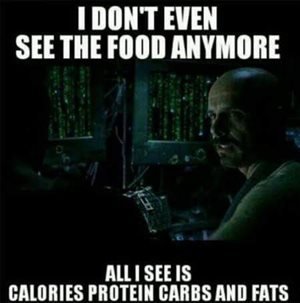When I was first asked to write a blog for the CMC intranet my initial thought was, “Sure! That will be a cool educational and promotional tool for the fitness center!” That thought was quickly followed up with a sense of panic and mild terror. “Uh-oh! What have I gotten myself into and how long will it be before I run out of subject matter to blog about?!?!?!?”, I thought to myself. When in actuality you, the fitness center regulars out there, have done a great job of giving me blog topic ideas! I find that the common questions that I get in the fitness center are making a nice list of blog topics. So thank you and keep those questions coming. Sorry, once again I digress, but this brings me to the subject at hand. In the last few weeks, I have been asked about or been in a conversation where macros have come up. So this seems like a pretty good time to address macros.
Just what are macros you ask? They are macronutrients, i.e. ‘macros’. So really they are nothing new. However, for a gym newbie overhearing the word macros being thrown around the gym or locker room, it may seem like the name of the newest and greatest supplement being peddled by Dr. Oz. or some other snake oil salesman. There are three macronutrients fats, proteins, and carbohydrates. Side note: depending on who you read, alcohol may be considered a macro as well. For the sake of our discussion we will stick to the big three, though.
macronutrients fats, proteins, and carbohydrates. Side note: depending on who you read, alcohol may be considered a macro as well. For the sake of our discussion we will stick to the big three, though.
Did you know we actually need some fat in our diet? Shocking right? It’s true! Our bodies need it to assist in vitamin absorption and transport of fat-soluble vitamins, for proper brain function, it is in every cell wall in the human body to control what goes in and out of our cells, just to name a few. Now keep in mind there are good fats and not so good fats. We will save that topic for a later date. For now though, good sources of fat would include fish, avocados, olive oil, and nuts, to name a few.
Next on the list of macros are proteins. Most folks would automatically think of proteins and think of their role in building muscle. Don’t get me wrong, this is a very important function, but their use goes way beyond that! For instance, they are present in both the outer and inner membranes of every living cell to hemoglobin, the protein compound that helps red blood cells carry oxygen throughout the human body. Were you aware that roughly half the dietary protein you take onboard goes to making enzymes? Why is that so important, you may ask? Those enzymes do some serious work for you such as to digest your food, assemble or divide molecules to make new cells for example.
The last of the macros would be carbohydrates, which can be subdivided into three types or categories of carbohydrates: simple, complex, and dietary fiber. It is the body’s first choice of fuel to burn for energy. Yes, your body can, through different paths of conversion, run on fat and protein as well, but when your body needs energy it looks for glucose from carbohydrates first. Now before I get called on the carpet for it, yes I know fiber is not an energy source. This is due to our inability to break down the sugar bonds in fiber during the digestive process. However, it is still listed as a carbohydrate so this is why I mention it here.
I am guessing right about now most of you are asking how many macros do I need a day & what type should they be? Or you may simply be asking why is this important to me at all? It is very important that you get a ratio of all three  in your diet! For example, if you are not getting enough protein during a calorie deficit you will begin to lose muscle mass. Another example would be if your fat intake is inadequate you will inhibit your body’s ability to utilize fat-soluble vitamins A, D, E, and K. I am guessing there are probably some of you who know what it feels like to workout with a low carbohydrate intake and how it can negatively affect your training performance. Sorry kids, that fourth macro I spoke of earlier is not a must have. I know some of you may think it is but alas it is not. I am walking proof, being that I haven’t consumed that adult liquid macro libation since college and let’s just say I didn’t graduate this past May from college! So that is evidence that three out of the four of those macronutrients are VERY critical.
in your diet! For example, if you are not getting enough protein during a calorie deficit you will begin to lose muscle mass. Another example would be if your fat intake is inadequate you will inhibit your body’s ability to utilize fat-soluble vitamins A, D, E, and K. I am guessing there are probably some of you who know what it feels like to workout with a low carbohydrate intake and how it can negatively affect your training performance. Sorry kids, that fourth macro I spoke of earlier is not a must have. I know some of you may think it is but alas it is not. I am walking proof, being that I haven’t consumed that adult liquid macro libation since college and let’s just say I didn’t graduate this past May from college! So that is evidence that three out of the four of those macronutrients are VERY critical.
Now that we know they are important, the next question is how much do I need every day? Let me start off by saying that there is no cookie cutter answer and will vary widely based on gender, age, weight, goals, activity level, and type of activity. Even that varies depending on what article you read or which online macro calculator you choose, and there are a lot of them! So if it seems as though I am being very vague here, I apologize because due to all the above factors the ranges of your daily needs of each macronutrient will vary quite a bit.
Let’s take protein for example. I am asked all the time in the gym, especially from guys, “How much protein do I need daily?” Well, according to Web MD & Wiki-may-or-may-not-be-right-opedia, men need 56g a day. No, ladies, I did not forget you! The same source says you need 46g a day. The RDA recommends .36g per lbs of body weight for anyone over 18yrs of age, which when I do the math on that with my body weight it comes out to 68.4g of protein total. ‘Nutrition for Dummies’ says 63g for men and 50g for women. A fairly common range I run into puts daily protein intake between .5g-1.5g per lbs of lean body mass. Again, activity level has a lot to do with how much protein you require per day. You can also easily search for how much fat and carbohydrate is required per day and again come up with a wide variety of ranges as well.
Now as if this wasn’t confusing enough you will also find recommendations for your daily ratio of carbs to fats to proteins as well and you guessed it, you will find tons of charts and graphs and online calculators that will vary this ratio. Take into account that a lot of these articles etc., are produced VERY generally and is pretty much a shotgun approach. All the variables mentioned earlier really do come into play, and we are all so very different in sizes, ages, goals and activity levels. Here is another example from my own life. I will regularly spend 4, 6, even up to 8hrs on the bike on any given Saturday riding in the hills above town. So my carbohydrate intake late in the week leading up to my long Saturday training rides tends to go up to meet that energy demand. Earlier in the week my diet tends to have a bit higher ratio of proteins when my mileage is down and I spend more time with resistance exercise. For me, the ratios of macros are very dependent on my activity during the week. Again that is just me and your goal is likely very different from mine.
This would also be a good time to give you a disclaimer. This blog is about the BASICS. Yes, I have a decent, general working knowledge of nutrition but this is NOT my wheelhouse. I would advise and encourage you to consult a nutritionist or dietitian to get the real skinny on this subject. This is their specialty and their expertise in the field is far and above mine. Ok, so a disclaimer and a little shameless plug as well for nutritionists.


